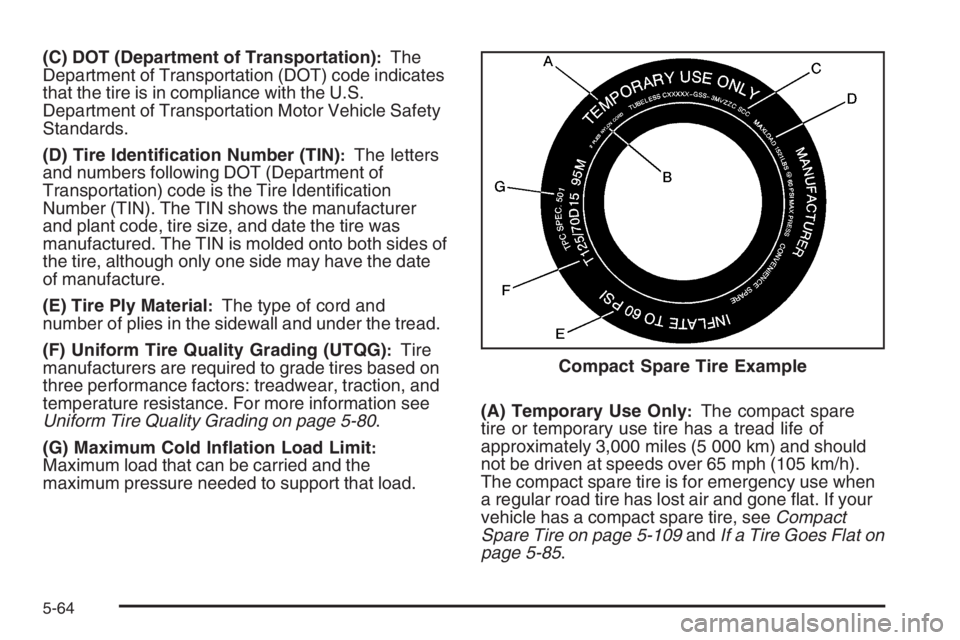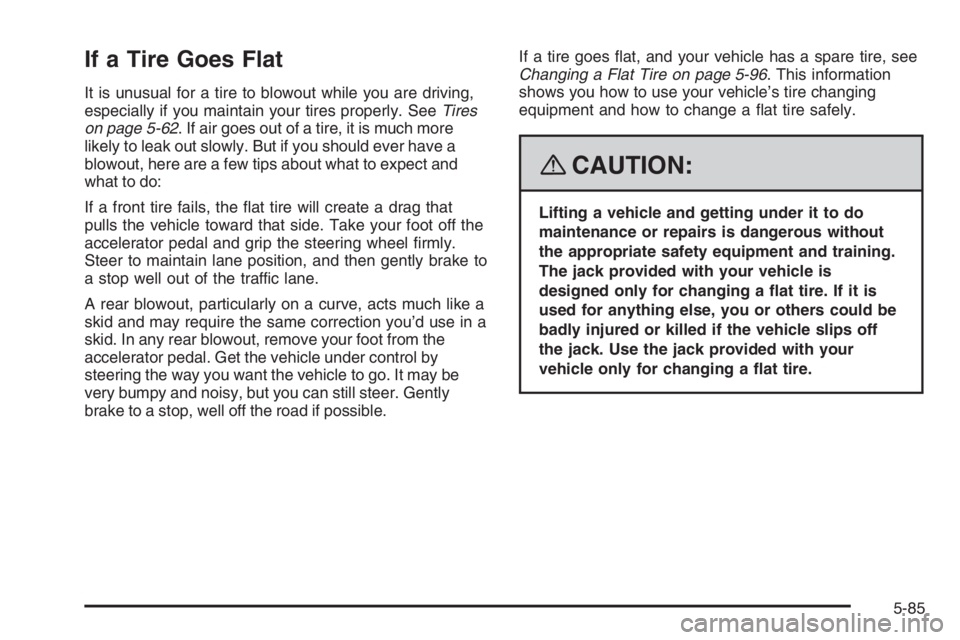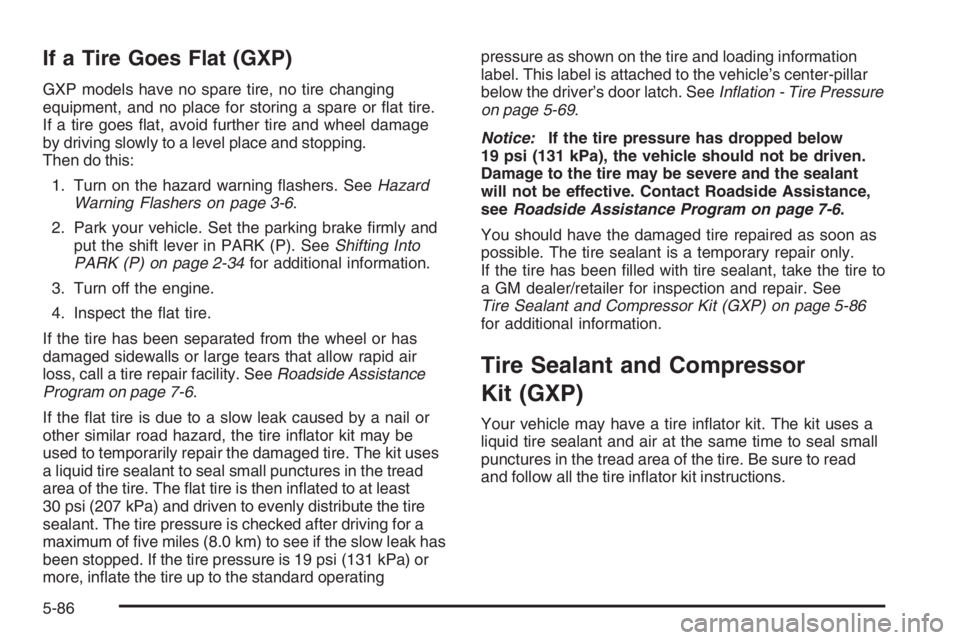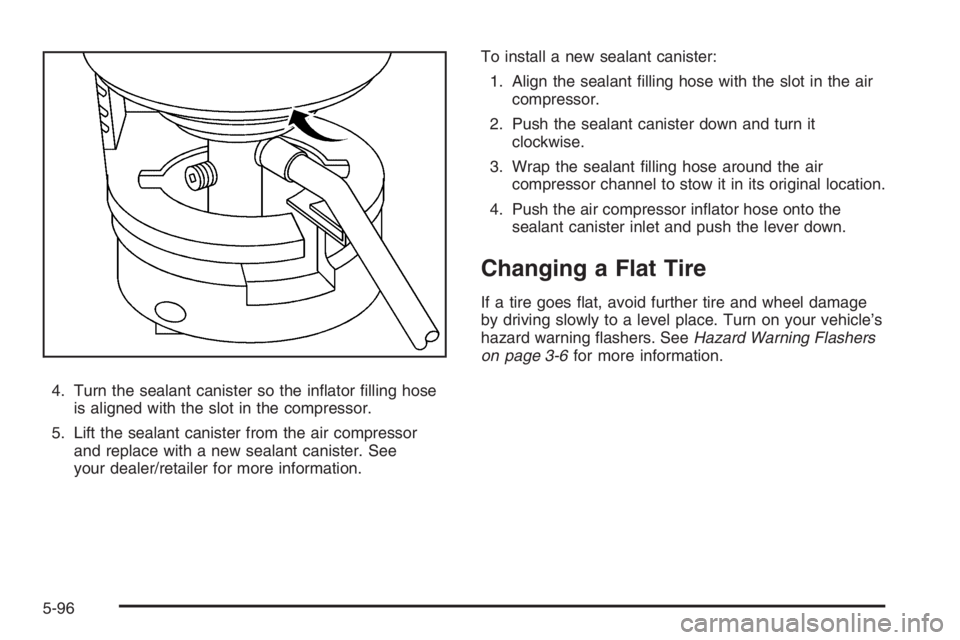2008 PONTIAC GRAND PRIX flat tire
[x] Cancel search: flat tirePage 272 of 450

Tire Pressure Monitor Operation.....................5-72
Tire Inspection and Rotation...........................5-75
When It Is Time for New Tires.......................5-77
Buying New Tires.........................................5-78
Different Size Tires and Wheels......................5-80
Uniform Tire Quality Grading..........................5-80
Wheel Alignment and Tire Balance..................5-82
Wheel Replacement......................................5-82
Tire Chains..................................................5-84
If a Tire Goes Flat........................................5-85
Tire Sealant and Compressor Kit (GXP)...........5-86
Changing a Flat Tire.....................................5-96
Removing the Spare Tire and Tools................5-98
Removing the Flat Tire and Installing the
Spare Tire..............................................5-100
Storing a Flat or Spare Tire and Tools...........5-107
Compact Spare Tire....................................5-109
Appearance Care..........................................5-109
Interior Cleaning.........................................5-109
Fabric/Carpet..............................................5-111
Leather......................................................5-112
Ultra Lux Suede..........................................5-113
Instrument Panel, Vinyl, and Other Plastic
Surfaces.................................................5-113
Care of Safety Belts....................................5-114Weatherstrips.............................................5-114
Washing Your Vehicle..................................5-114
Cleaning Exterior Lamps/Lenses....................5-115
Finish Care................................................5-115
Windshield and Wiper Blades.......................5-116
Aluminum Wheels.......................................5-116
Tires.........................................................5-117
Sheet Metal Damage...................................5-117
Finish Damage...........................................5-117
Underbody Maintenance...............................5-117
Chemical Paint Spotting...............................5-118
Vehicle Care/Appearance Materials................5-118
Vehicle Identi�cation.....................................5-119
Vehicle Identi�cation Number (VIN)................5-119
Service Parts Identi�cation Label...................5-120
Electrical System..........................................5-120
Add-On Electrical Equipment.........................5-120
Headlamp Wiring........................................5-120
Windshield Wiper Fuses...............................5-121
Power Windows and Other Power Options......5-121
Fuses and Circuit Breakers..........................5-121
Instrument Panel Fuse Block........................5-122
Underhood Fuse Block................................5-124
Capacities and Speci�cations........................5-128
Section 5 Service and Appearance Care
5-2
Page 334 of 450

(C) DOT (Department of Transportation):The
Department of Transportation (DOT) code indicates
that the tire is in compliance with the U.S.
Department of Transportation Motor Vehicle Safety
Standards.
(D) Tire Identi�cation Number (TIN)
:The letters
and numbers following DOT (Department of
Transportation) code is the Tire Identi�cation
Number (TIN). The TIN shows the manufacturer
and plant code, tire size, and date the tire was
manufactured. The TIN is molded onto both sides of
the tire, although only one side may have the date
of manufacture.
(E) Tire Ply Material
:The type of cord and
number of plies in the sidewall and under the tread.
(F) Uniform Tire Quality Grading (UTQG)
:Tire
manufacturers are required to grade tires based on
three performance factors: treadwear, traction, and
temperature resistance. For more information see
Uniform Tire Quality Grading on page 5-80.
(G) Maximum Cold In�ation Load Limit
:Maximum load that can be carried and the
maximum pressure needed to support that load.(A) Temporary Use Only
:The compact spare
tire or temporary use tire has a tread life of
approximately 3,000 miles (5 000 km) and should
not be driven at speeds over 65 mph (105 km/h).
The compact spare tire is for emergency use when
a regular road tire has lost air and gone �at. If your
vehicle has a compact spare tire, seeCompact
Spare Tire on page 5-109andIf a Tire Goes Flat on
page 5-85. Compact Spare Tire Example
5-64
Page 346 of 450

The purpose of a regular tire rotation is to achieve
a uniform wear for all tires on the vehicle. This will
ensure that your vehicle continues to perform most
like it did when the tires were new.
Any time you notice unusual wear, rotate your
vehicle’s tires as soon as possible and check the
wheel alignment. Also check for damaged tires
or wheels. SeeWhen It Is Time for New Tires on
page 5-77andWheel Replacement on page 5-82
for more information.
The correct rotation pattern shown here is only for
non-GXP tires.
Do not include a compact spare tire, if your
vehicle has one, in the vehicle’s tire rotation.After the tires have been rotated, adjust the front
and rear in�ation pressures as shown on the Tire
and Loading Information label, and reset the Tire
Pressure Monitor System. SeeTire Pressure
Monitor System on page 5-71for additional
information.
Make certain that all wheel nuts are properly
tightened. See “Wheel Nut Torque” under
Capacities and Specifications on page 5-128.
{CAUTION:
Rust or dirt on a wheel, or on the parts to
which it is fastened, can make wheel nuts
become loose after time. The wheel could
come off and cause an accident. When
you change a wheel, remove any rust or
dirt from places where the wheel attaches
to the vehicle. In an emergency, you can
use a cloth or a paper towel to do this; but
be sure to use a scraper or wire brush later,
if needed, to get all the rust or dirt off.
SeeChanging a Flat Tire on page 5-96.
Rotation Pattern for Non-GXP Tires Only
5-76
Page 353 of 450

{CAUTION:
Using the wrong replacement wheels, wheel
bolts, or wheel nuts on your vehicle can be
dangerous. It could affect the braking and
handling of your vehicle, make your tires lose
air and make you lose control. You could have
a collision in which you or others could be
injured. Always use the correct wheel, wheel
bolts, and wheel nuts for replacement.
Notice:The wrong wheel can also cause problems
with bearing life, brake cooling, speedometer or
odometer calibration, headlamp aim, bumper height,
vehicle ground clearance, and tire or tire chain
clearance to the body and chassis.
SeeChanging a Flat Tire on page 5-96for more
information.
Used Replacement Wheels
{CAUTION:
Putting a used wheel on your vehicle is
dangerous. You cannot know how it has been
used or how far it has been driven. It could fail
suddenly and cause a crash. If you have to
replace a wheel, use a new GM original
equipment wheel.
5-83
Page 355 of 450

If a Tire Goes Flat
It is unusual for a tire to blowout while you are driving,
especially if you maintain your tires properly. SeeTires
on page 5-62. If air goes out of a tire, it is much more
likely to leak out slowly. But if you should ever have a
blowout, here are a few tips about what to expect and
what to do:
If a front tire fails, the �at tire will create a drag that
pulls the vehicle toward that side. Take your foot off the
accelerator pedal and grip the steering wheel �rmly.
Steer to maintain lane position, and then gently brake to
a stop well out of the traffic lane.
A rear blowout, particularly on a curve, acts much like a
skid and may require the same correction you’d use in a
skid. In any rear blowout, remove your foot from the
accelerator pedal. Get the vehicle under control by
steering the way you want the vehicle to go. It may be
very bumpy and noisy, but you can still steer. Gently
brake to a stop, well off the road if possible.If a tire goes �at, and your vehicle has a spare tire, see
Changing a Flat Tire on page 5-96. This information
shows you how to use your vehicle’s tire changing
equipment and how to change a �at tire safely.
{CAUTION:
Lifting a vehicle and getting under it to do
maintenance or repairs is dangerous without
the appropriate safety equipment and training.
The jack provided with your vehicle is
designed only for changing a �at tire. If it is
used for anything else, you or others could be
badly injured or killed if the vehicle slips off
the jack. Use the jack provided with your
vehicle only for changing a �at tire.
5-85
Page 356 of 450

If a Tire Goes Flat (GXP)
GXP models have no spare tire, no tire changing
equipment, and no place for storing a spare or �at tire.
If a tire goes �at, avoid further tire and wheel damage
by driving slowly to a level place and stopping.
Then do this:
1. Turn on the hazard warning �ashers. SeeHazard
Warning Flashers on page 3-6.
2. Park your vehicle. Set the parking brake �rmly and
put the shift lever in PARK (P). SeeShifting Into
PARK (P) on page 2-34for additional information.
3. Turn off the engine.
4. Inspect the �at tire.
If the tire has been separated from the wheel or has
damaged sidewalls or large tears that allow rapid air
loss, call a tire repair facility. SeeRoadside Assistance
Program on page 7-6.
If the �at tire is due to a slow leak caused by a nail or
other similar road hazard, the tire in�ator kit may be
used to temporarily repair the damaged tire. The kit uses
a liquid tire sealant to seal small punctures in the tread
area of the tire. The �at tire is then in�ated to at least
30 psi (207 kPa) and driven to evenly distribute the tire
sealant. The tire pressure is checked after driving for a
maximum of �ve miles (8.0 km) to see if the slow leak has
been stopped. If the tire pressure is 19 psi (131 kPa) or
more, in�ate the tire up to the standard operatingpressure as shown on the tire and loading information
label. This label is attached to the vehicle’s center-pillar
below the driver’s door latch. SeeInflation - Tire Pressure
on page 5-69.
Notice:If the tire pressure has dropped below
19 psi (131 kPa), the vehicle should not be driven.
Damage to the tire may be severe and the sealant
will not be effective. Contact Roadside Assistance,
seeRoadside Assistance Program on page 7-6.
You should have the damaged tire repaired as soon as
possible. The tire sealant is a temporary repair only.
If the tire has been �lled with tire sealant, take the tire to
a GM dealer/retailer for inspection and repair. See
Tire Sealant and Compressor Kit (GXP) on page 5-86
for additional information.
Tire Sealant and Compressor
Kit (GXP)
Your vehicle may have a tire in�ator kit. The kit uses a
liquid tire sealant and air at the same time to seal small
punctures in the tread area of the tire. Be sure to read
and follow all the tire in�ator kit instructions.
5-86
Page 366 of 450

4. Turn the sealant canister so the in�ator �lling hose
is aligned with the slot in the compressor.
5. Lift the sealant canister from the air compressor
and replace with a new sealant canister. See
your dealer/retailer for more information.To install a new sealant canister:
1. Align the sealant �lling hose with the slot in the air
compressor.
2. Push the sealant canister down and turn it
clockwise.
3. Wrap the sealant �lling hose around the air
compressor channel to stow it in its original location.
4. Push the air compressor in�ator hose onto the
sealant canister inlet and push the lever down.
Changing a Flat Tire
If a tire goes �at, avoid further tire and wheel damage
by driving slowly to a level place. Turn on your vehicle’s
hazard warning �ashers. SeeHazard Warning Flashers
on page 3-6for more information.
5-96
Page 370 of 450

Removing the Flat Tire and
Installing the Spare Tire
Your vehicle may have aluminum wheels. If so, you will
see exposed stainless steel wheel nuts. Use the wheel
wrench to loosen all the wheel nuts. Do not remove
them yet.
Or, your vehicle may have steel wheel covers.To remove the steel wheel covers and wheel nut caps,
loosen the plastic nut caps with the wheel wrench in a
counterclockwise direction. If needed, you can �nish
loosening them with your �ngers. The plastic nut caps will
not come off.
Use the �at end of the wheel wrench and pry along the
edge of the cover until it comes off. The edge of the
wheel cover could be sharp, so do not try to remove it
with your bare hands. Do not drop the cover or lay it
face down, as it could become scratched or damaged.
Store the wheel cover in the trunk until the �at tire is
repaired or replaced.
5-100